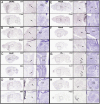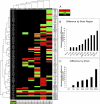Divergent and nonuniform gene expression patterns in mouse brain
- PMID: 20956311
- PMCID: PMC2973884
- DOI: 10.1073/pnas.1003732107
Divergent and nonuniform gene expression patterns in mouse brain
Abstract
Considerable progress has been made in understanding variations in gene sequence and expression level associated with phenotype, yet how genetic diversity translates into complex phenotypic differences remains poorly understood. Here, we examine the relationship between genetic background and spatial patterns of gene expression across seven strains of mice, providing the most extensive cellular-resolution comparative analysis of gene expression in the mammalian brain to date. Using comprehensive brainwide anatomic coverage (more than 200 brain regions), we applied in situ hybridization to analyze the spatial expression patterns of 49 genes encoding well-known pharmaceutical drug targets. Remarkably, over 50% of the genes examined showed interstrain expression variation. In addition, the variability was nonuniformly distributed across strain and neuroanatomic region, suggesting certain organizing principles. First, the degree of expression variance among strains mirrors genealogic relationships. Second, expression pattern differences were concentrated in higher-order brain regions such as the cortex and hippocampus. Divergence in gene expression patterns across the brain could contribute significantly to variations in behavior and responses to neuroactive drugs in laboratory mouse strains and may help to explain individual differences in human responsiveness to neuroactive drugs.
Conflict of interest statement
The authors declare no conflict of interest.
Figures



Similar articles
-
Association of brain immune genes with social behavior of inbred mouse strains.J Neuroinflammation. 2015 Apr 18;12:75. doi: 10.1186/s12974-015-0297-5. J Neuroinflammation. 2015. PMID: 25895500 Free PMC article.
-
Characterization of the blood-brain barrier in genetically diverse laboratory mouse strains.Fluids Barriers CNS. 2021 Jul 28;18(1):34. doi: 10.1186/s12987-021-00269-w. Fluids Barriers CNS. 2021. PMID: 34321020 Free PMC article.
-
Human and murine osteocalcin gene expression: conserved tissue restricted expression and divergent responses to 1,25-dihydroxyvitamin D3 in vivo.Mol Endocrinol. 1997 Oct;11(11):1695-708. doi: 10.1210/mend.11.11.0008. Mol Endocrinol. 1997. PMID: 9328351
-
Development of high-throughput tools to unravel the complexity of gene expression patterns in the mammalian brain.Novartis Found Symp. 2001;239:129-46; discussion 146-59. doi: 10.1002/0470846674.ch11. Novartis Found Symp. 2001. PMID: 11529308 Review.
-
Human inter-individual DNA sequence variation in candidate genes, drug targets, the importance of haplotypes and pharmacogenomics.Curr Pharm Biotechnol. 2003 Dec;4(6):351-78. doi: 10.2174/1389201033377300. Curr Pharm Biotechnol. 2003. PMID: 14683431 Review.
Cited by
-
Unsupervised pattern identification in spatial gene expression atlas reveals mouse brain regions beyond established ontology.Proc Natl Acad Sci U S A. 2024 Sep 10;121(37):e2319804121. doi: 10.1073/pnas.2319804121. Epub 2024 Sep 3. Proc Natl Acad Sci U S A. 2024. PMID: 39226356 Free PMC article.
-
Anatomical Diversity of the Adult Corticospinal Tract Revealed by Single-Cell Transcriptional Profiling.J Neurosci. 2023 Nov 22;43(47):7929-7945. doi: 10.1523/JNEUROSCI.0811-22.2023. J Neurosci. 2023. PMID: 37748862 Free PMC article.
-
Merged magnetic resonance and light sheet microscopy of the whole mouse brain.Proc Natl Acad Sci U S A. 2023 Apr 25;120(17):e2218617120. doi: 10.1073/pnas.2218617120. Epub 2023 Apr 17. Proc Natl Acad Sci U S A. 2023. PMID: 37068254 Free PMC article.
-
Network Neuroscience Untethered: Brain-Wide Immediate Early Gene Expression for the Analysis of Functional Connectivity in Freely Behaving Animals.Biology (Basel). 2022 Dec 24;12(1):34. doi: 10.3390/biology12010034. Biology (Basel). 2022. PMID: 36671727 Free PMC article. Review.
-
Single Cell Transcriptome Analysis of Niemann-Pick Disease, Type C1 Cerebella.Int J Mol Sci. 2020 Jul 28;21(15):5368. doi: 10.3390/ijms21155368. Int J Mol Sci. 2020. PMID: 32731618 Free PMC article.
References
Publication types
MeSH terms
Grants and funding
LinkOut - more resources
Full Text Sources

